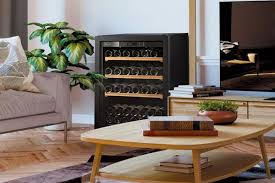Why Your Allavino Wine Cooler Shouldn’t Be Next to the Oven (and Other Placement Tips)

Placing your Allavino wine cooler next to your oven can seriously compromise its performance and your wine’s quality. The heat radiating from ovens—even when not in active use—creates temperature fluctuations that force the cooler to work harder, potentially damaging both the appliance and your precious wine collection.
Wine storage isn’t just about keeping your bottles cold. It’s about keeping them consistently cool, away from heat, light, and vibrations. Let’s explore exactly why placement matters, why the oven is one of the worst neighbors for your cooler, and where your wine fridge should go to protect every sip.
The Science Behind Wine Storage: Why Stability is Key
Wine is a living, evolving product. Unlike canned goods or sodas, wine continues to develop after it’s bottled. That evolution is delicate and easily thrown off balance by environmental changes. According to expert sommeliers, even small temperature shifts—say, five degrees in a day—can disturb wine’s chemical structure, flatten its flavor profile, or accelerate unwanted aging.
This is where a Allavino wine fridge shines. It’s designed to maintain ideal temperatures (typically 45–65°F) and keep your bottles free from external stress. But for your fridge to do its job properly, where you place it matters just as much as how it’s built.
Why the Oven is the Worst Spot for a Allavino Wine Cooler
Kitchens are convenient, but not all kitchen corners are created equal. Ovens, stoves, and other cooking appliances produce radiant and ambient heat. Even when they’re off, ovens retain warmth for hours—and that heat radiates outward into surrounding cabinetry and counters.
If your Allavino wine cooler sits right next to it, here’s what can happen:
- Temperature Swings: Ovens can cause the surrounding area to spike in temperature. These fluctuations stress the wine cooler’s compressor.
- Compressor Overload: To maintain internal consistency, the unit must run longer and harder. This increases wear and energy costs.
- Wine Degradation: Even a slight rise in temperature inside the cooler can negatively affect sensitive reds, whites, and sparkling wines.
Over time, this placement results in a loss of both wine quality and cooler efficiency. In worst-case scenarios, it can shorten the appliance’s lifespan entirely.
Placement Tip #1: Give It Room to Breathe
Wine coolers need ventilation to dissipate heat from the cooling process. Crowding your fridge against walls or tucking it tightly between appliances blocks this airflow.
If you’re working with a freestanding model, leave at least 2–4 inches of clearance on all sides. For built-in models, like many offered in the Allavino wine refrigerator line, front ventilation allows for under-counter placement. Still, you’ll want to avoid boxing it in entirely.
Placement Tip #2: Keep It Out of Direct Sunlight
Just like heat, UV light is an enemy of wine. Prolonged exposure can cause a reaction known as “light strike,” which degrades wine compounds and leads to off-flavors—often described as “skunky” or “flat.”
Most Allavino units are built with UV-resistant glass doors to help block harmful rays. But even so, direct sunlight beating down on the door can raise the internal temperature and force the cooler to overwork.
Consider placing your unit in a shaded area or behind a light curtain if it must be near a window. Bonus: darker environments are also more aesthetically appealing for displaying your wine.
Placement Tip #3: Steer Clear of Vibration Sources
Constant motion, even tiny vibrations, can disturb the natural sediment in wine and hinder the aging process. That’s why quality wine coolers are engineered to dampen movement from the internal compressor.
But what about external vibrations? Placing your cooler next to a dishwasher, laundry room wall, or heavy foot traffic area can introduce subtle but damaging shifts. Over time, this compromises flavor clarity—especially for wines that benefit from aging.
Find a stable, low-traffic corner for your fridge. An under-the-stairs nook or recessed pantry wall could work beautifully.
Placement Tip #4: Avoid Extreme Ambient Conditions
Wine coolers are designed to operate within a reasonable room temperature range. Extreme cold (below 50°F) or heat (above 90°F) can throw off the internal cooling system and affect performance.
Many people are tempted to install their wine cooler in garages or uninsulated basements. However, if those areas experience big temperature swings, even the best wine fridge can’t compensate. If a garage is your only option, be sure it’s climate-controlled.
Placement Tip #5: Think About Accessibility and Lifestyle
Where do you enjoy wine most? If it’s with dinner, place the cooler close to the dining area—but not too close to ovens or stoves. If it’s for hosting, a wine fridge near the living room or entertainment space could work better.
You’ll also want to consider power supply. Always plug the cooler directly into a wall outlet (never an extension cord) to avoid electrical risks. If noise is a concern, Allavino coolers are known for being ultra-quiet, so placement near living spaces is rarely a problem.
Real-Life Insight: What Happens When You Get Placement Wrong
Let’s say you install your wine cooler directly beside the oven. Every time you preheat to 400°F, the surrounding cabinetry heats up. This heat slowly seeps into your cooler’s side panel. Over the course of a single week, you’ve unknowingly forced the compressor to cycle on and off 30–40% more than necessary.
Now imagine doing that for a year.
Not only will your cooler age prematurely, but the risk of internal temperature drift increases—especially during summer months. Wines stored in these conditions will lose aroma, structure, and even color.
A simple shift—like moving the unit just two feet away from the oven—can make a dramatic difference in performance and wine quality.
FAQs: Quick Placement Answers for Everyday Wine Lovers
Can I put my Allavino wine cooler under the kitchen counter?
Yes, if it’s a built-in model with front ventilation. Always check your model type before integrating it into cabinetry.
What if I don’t have room away from the oven?
Try placing a thermal barrier between the two, such as an insulating cabinet or vertical storage shelf. But whenever possible, distance is better than insulation alone.
Is it safe to place the wine cooler in my bedroom or office?
Absolutely. In fact, bedrooms and offices often offer the consistent temperature and low light conditions wine needs. Just ensure it’s not near heating vents or direct sun.
Can I place my wine cooler in an outdoor kitchen?
Only if the area is fully shaded, ventilated, and the cooler is rated for outdoor use. Most indoor units, including many Allavino models, are not designed for fluctuating external environments.
Final Thoughts: A Simple Choice with Lasting Impact
Wine coolers are more than stylish accessories. They’re precision tools designed to protect one of life’s simplest luxuries: a great glass of wine. But even the finest Allavino wine cooler can’t overcome poor placement decisions.
Avoid heat. Stay out of the sun. Keep it steady. Think beyond convenience and consider the bigger picture—because where you place your cooler will directly impact how your wine tastes today, tomorrow, and years from now.
Source : https://ibhomeluxuries.blogspot.com/2025/07/why-your-allavino-wine-cooler-shouldnt.html



